 Iran’s Attack on Israel
Iran’s Attack on Israel
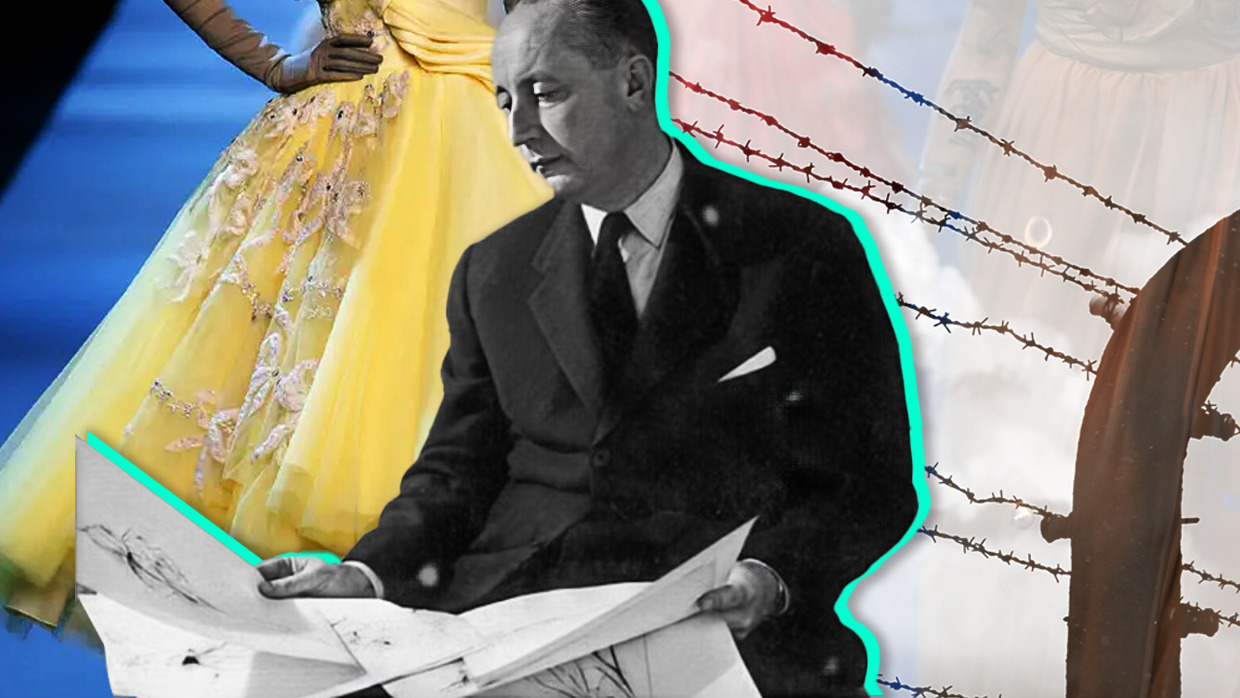

13 min read
The true story behind Apple TV’s new series about the fashion designer’s actions during and after WWII.
Apple TV’s New Look is described as an “emotionally thrilling series” about “the shocking story of how fashion icon Christian Dior and his contemporaries…navigated the horrors of World War II and launched modern fashion.”
Biographies of Dior often emphasize his work with the wives of high-ranking Nazis during World War II. While Jews and others were being deported, tortured, and murdered in France and across Europe, Dior spent most of the Second World War in Paris, measuring and dressing German and other women with close ties to Nazi officials. Yet Christian Dior had another, less well-known side: his beloved sister Catherine was a hero in the French Resistance, and Christian offered her both emotional and material support through some of the war’s darkest times.
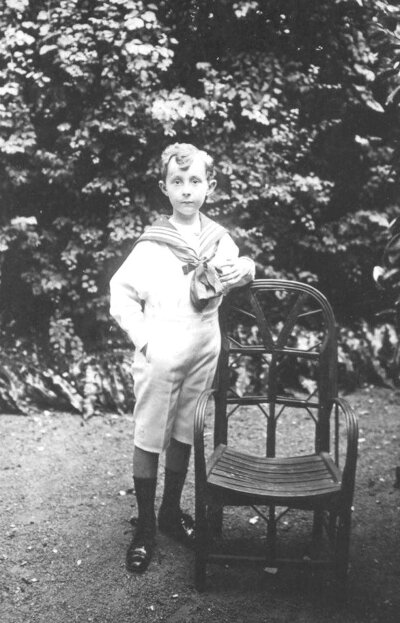
Here are a few facts about Christian Dior and the remarkable legacy he left behind.
Dior was born into a wealthy family in the picturesque French town of Granville in 1905, located in the Normandy region of France. The hyper feminine clothes that would eventually make Dior famous harked back to the romance and beauty of his childhood home before the devastation of World War I.
Dior would conjure this magical time again and again in his fashion designs. “I picture it now as a happy, jaunty, peaceful time when all we thought about was enjoying life. We were carefree in the belief that no harm threatened the wealth and lifestyle of the rich nor the simple, thrifty existence of the poor. To us the future would bring nothing but even greater benefits for all. Whatever life might have bestowed upon me since, nothing can rival my memories of those sweet years,” he later recalled. (Quoted in Christian Dior: The Man Who Made the World Look New by Marie-France Pochna: 1994)

During the Great Depression, the Dior family lost its fortune. Christian became a fashion designer, then an art dealer, selling works by avant garde painters in Paris. Many of the painters he championed were Jews, such as Max Jacob, Man Ray, and Eugene and Leonid Berman. The goal of the gallery he ran with his business partner Jacques Bonjean “was to introduce the painters we know personally and already admire greatly.” Unlike some Frenchmen at the time, Dior mixed freely with Jews, betraying no antisemitism or sense of social superiority.
When World War II broke out, Dior was drafted into the French army and put to work farming in the French countryside. It was backbreaking work, but he enjoyed it. Dior realized that 1.5 million French soldiers had been captured by Nazi troops and were languishing in POW camps in Germany, and that he was lucky to have been spared.
In 1941, Christian Dior was released from the army and returned to Paris and resumed fashion designing, landing a job in the Lucien Lelong fashion house where he partnered with an up and coming designer named Pierre Balmain to create wartime fashions.
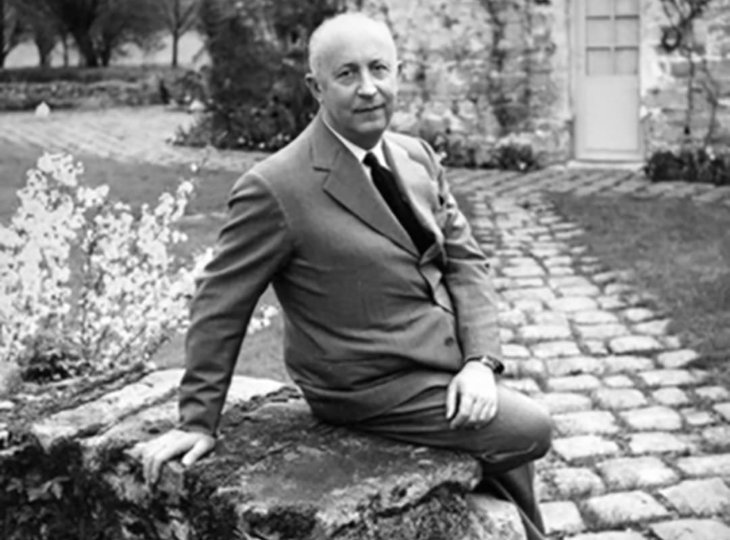
Lucien Lelong was a complex figure. He was president of the Chambre Syndicale, the organization representing the whole of the French couture industry. All French fashion houses closed down in 1939; in 1941, under German rule, a handful reopened, including Lelong’s. For years, Lelong negotiated with Nazi officials, resisting calls to move the French fashion industry to Austria or Germany. He argued that French fashion design was reliant on countless workshops in Paris and elsewhere in France which manufactured the ribbons and lace, the silks, buttons, thread, and other items necessary for every couture creation. Writer Germaine Beaumont observed in 1942 that even though a French couture dress might seem “such a little thing, so light and yet the sum of civilizations, the quintessence of equilibrium, of moderation, of grace…because a Paris gown is not really made of cloth, it is made with the streets, with the colonnades…it is gleaned from life and from books, from museums and from the unexpected events of the day. It is no more than a gown yet the whole country has made this gown…” (Quoted in Miss Dior: A Story of Courage and Couture by Justine Picardie: 2021) It was a view that Dior shared.
Most of Lucien Lelong’s customers were the wives and girlfriends of high-ranking Nazis, the only people in Paris who could afford couture dresses. Many of the Frenchmen working in couture were only too happy to oblige. When French Jewish couturiers and clothing designers such as Jacques Heim and Lotka de Prevaux were forced to close and later deported, the French couture industry made no complaints. Many openly despised their former Jewish customers; the famous designer Marcel Rochas crossed the street when he spied former Jewish customers, avoiding them.
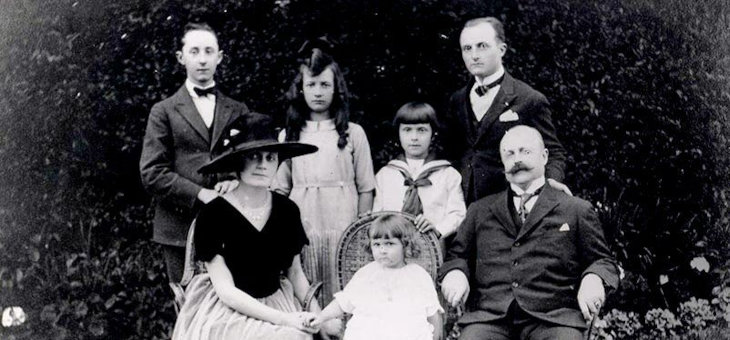 The Diors
The Diors
Designer Elsa Schiaparelli outfitted Suzanne Abetz, the wife of Otto Abetz, Germany’s fanatically antisemitic Ambassador to France. Former Harper's Bazaar editor Justine Picardie describes a tragic incident at a Schiaparelli fashion show: Elisabeth de Rothschild changed her seat so that she wouldn’t be sitting next to Ms. Abetz. In retaliation, Abetz had de Rothschild deported to the Ravensbruck concentration camp where she died.
Christian Dior’s beloved younger sister Catherine was born in 1917 when he was 12. Of the five Dior children, Christian and Catherine became the closest to one another, enjoying a bond throughout their lives.
 The Dior Children
The Dior Children
In 1941, as her brother was embarking on his fashion career in Paris, Catherine lived in Cannes in the Vichy region of southern France. Although the Vichy government was dictatorial and enforced a pro-German, anti-Jewish culture and policies, Catherine had a fiercely independent streak and was devoted to a vision of France that reflected the tolerance and openness she and her brother had witnessed before the war.
In Vichy France, it was a serious offense to listen to the radio broadcasts of Gen. Charles de Gaulle, the French hero who led the Free French government in exile in Britain. Defying arrest and imprisonment, Catherine visited a radio shop in the city of Cannes to buy a battery powered radio. In the shop, she met the manager, Herve des Charbonneries, an underground resistance hero who became her lover and who recruited Catherine into the world of the French Resistance.
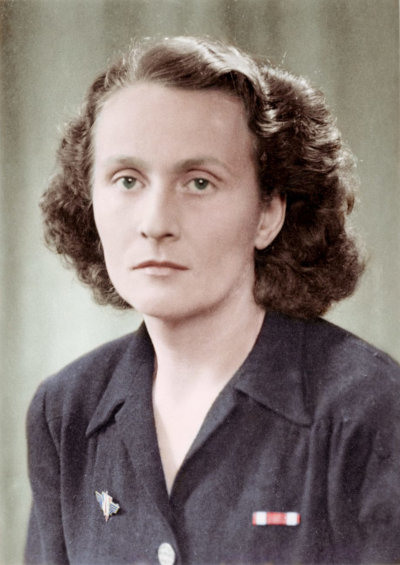 Catherine Dior
Catherine Dior
Their unit was called F2, and was initially set up by members of Polish intelligence service. The men who set up F2 were forced to flee France. They settled in London where British Intelligence helped them offer support and materials to F2 agents in France. By the end of the war, F2 had about 2,500 active agents in France; nearly a quarter of them were women. Catherine was given the code name “Caro” and disseminated information about German troop movements to the Allies.
During one raid by the Gestapo on F2’s Cannes headquarters, Catherine hid secret materials before spiriting them out of the office. F2’s archives note her “composure, decisiveness, and sang-froid” in the face of imminent discovery.
In some small ways, Christian lent his support to the Resistance too, by allowing Catherine and her friends in the Resistance hid in Christian’s Paris apartment; a small attic room allowed them to escape detection. In spring of 1944, “Caro’s” identity became known to the Vichy authorities. Catherine fled Cannes and stayed with her brother in Paris.
On June 6 1944, Catherine Dior’s luck ran out. She was tracked and arrested by the French Gestapo in Paris and sent to a fearsome torture center on the Rue de la Pompe. She later described what happened next: “When I arrived in the building, I was immediately subjected to an interrogation on my activities for the Resistance and also on the identity of the chiefs under whose orders I was working. This interrogation was accompanied by brutalities: punching, kicking, slapping, etc. When the interrogation proved unsatisfactory, I was taken to the bathroom. They undressed me, bound my hands and plunged me into the (cold) water, where I remained for about three-quarters of an hour…. From time to time, they submerged me completely and immediately afterwards they questioned me… I lied to them as much as I could.” (Quoted in Miss Dior: A Story of Courage and Couture by Justine Picardie: 2021)

The French Resistance considered it a success if their members resisted torture for 24 hours. Catherine Dior never divulged the names of her fellow F2 members, despite being brutally tortured over and over again, and kept in ice water for hours at a time. Her torture was so brutal that she was never able to have children. To this day, scratched on the wall of the Gestapos’ center are the words “We have been tortured by the French people.”
At one point, the Gestapo issued a notice that Catherine had died, then issued another statement that she was still living. Christian Dior was frantic with worry. He phoned all his contacts to try and get his sister released. He was unsuccessful and Catherine was deported to Ravensbruck concentration camp where she was subjected to forced slave labor. She was then sent to Abteroda, a subcamp of Buchenwald, where she slaved alongside other starved, emaciated women working 12 hours a day making parts for BMW.
With the US Army closing in on Buchenwald in April 1945, Nazi guards forced Catherine, along with hundreds of thousands of other concentration camp slave laborers, on a protracted death march deeper into Nazi-held territory. About a third of prisoners on these marches died, approximately a quarter of a million people. Catherine survived a forced march to Dresden, where she somehow managed to escape from the rest of the prisoners, hiding in the city’s rubble. She was eventually liberated by the Soviet Army, and possibly was subject to sexual abuse by Soviet soldiers.
Catherine made it back to France on May 28, 1945. Christian Dior had been sick with worry throughout her imprisonment. He later wrote that “I exhausted myself in vain in trying to trace her. Work – exigent, all-absorbing work – was the only drug which enabled me to forget.”
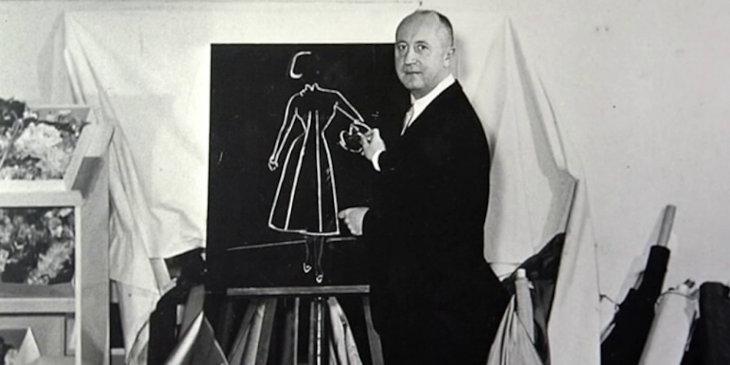
Christian met Catherine at the train station in Paris, but didn’t recognize her at first because she was so ill and thin. He took her back to his apartment and presented her with her favorite meal, a cheese souffle. Catherine was so sick she wasn’t able to eat it. She stayed with her brother and was soon joined in the apartment by Herve des Charbonneries who trained her as a flower dealer and began to rebuild her life.
Catherine Dior was awarded France’s highest awards, including the Legion of Honor, the Croix de Guerre, the King’s Medal for Courage in the Cause of Freedom, and the Cross of the Resistance Volunteer Combat. She died in 2008 at the age of 91.
Throughout the war, high fashion was an impossible luxury: only the wives and lovers of Nazis and their sympathizers were able to afford stylish or new clothing. After years of dressing in drab, old, and skimpy clothes, Dior felt that women longed to feel feminine again. He noted that throughout the war, even when they dressed in rags, Parisian women sported creative, colorful, handmade hats. Surely, he felt, it was time to design beautiful clothes.
In 1946, Dior left Lucien Lelong’s house and founded his own fashion label. He scheduled his first show for February 1947. When his models strode onto the stage wearing his new ensembles, they scandalized a war-weary population. In contrast to the tight, plain clothes worn throughout the war, Dior’s clothes were extravagantly luxurious. Even though fabric was still being rationed, Dior featured long skirts and billowy drapes which required yard after yard of expensive materials; the average ensemble required 20 yards of fabric, an unthinkable amount at the time. Carmel Snow, the fashion editor of Harper’s Bazaar, declared “Monsieur Dior, you’ve given us such a New Look!” The moniker stuck.
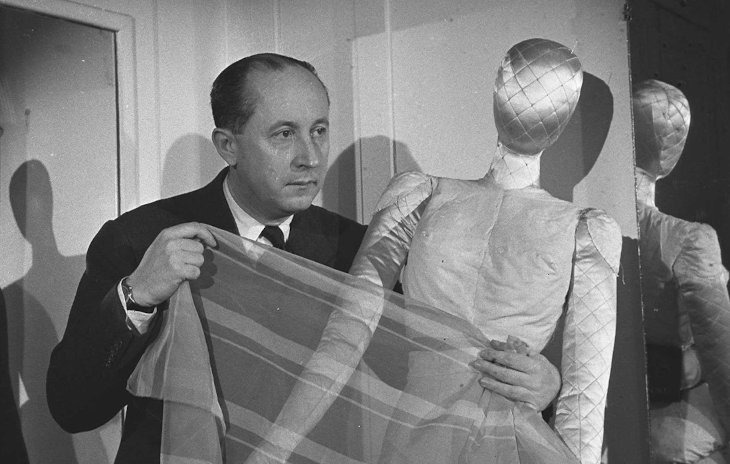
Not everyone was enamored with Dior’s “New Look”. Britain’s King George V refused to let his daughters Princess Elizabeth and Princess Margaret wear Dior’s extravagant fashions, thinking it was in poor taste to display such luxury when their country was still rationing food. Hollywood stars flocked to the new style, and Dior’s full skirts and cinched waists soon became the defining fashion of the late 1940s and early 1950s.
One of Dior’s most enduring products is named in honor of Catherine. In 1946, Dior created his first perfume, a floral medley with notes of lily of the valley, Dior’s favorite flower and a plant that he knew Catherine traded in. He named his first perfume Miss Dior as a lasting tribute to his heroic sister.
In 1955, Dior hired a teenager named Yves Saint Laurent to assist him. Two years later, Dior told Laurent’s mother that he wanted Laurent to head Dior after he died. Laurent’s mother was confused: after all, Dior was only in his early fifties and would likely continue to head his flourishing fashion house for many years to come. Yet soon after that conversation Dior suffered a massive heart attack and died at the age of 52. After a period of confusion, Yves Saint Laurent did become the chief designer of the Dior fashion house, before being replaced by Marc Bohan, who continued to ensure that Dior was a dominant force in French high fashion.
Today, Dior is owned by the LVMH conglomerate which counts many of the world’s luxury brands in its portfolio. From 1997 to 2011, Dior’s Creative Director was the British fashion designer John Galliano. He was fired after making a series of drunken, antisemitic rants in Paris bars. In one typical incident, Galliano yelled at a woman “I love Hitler. People like you would be dead. Your mothers, your forefathers, would all be (expletive) gassed.”
Dior’s current Creative Director is Maria Grazia Chiuri, who’s made waves recently with her latest collection, featuring moire silk and draped silhouettes. Dior’s most recent ad campaign featured proud Israeli model May Tagher, a role previously held by Bella Hadid, an international model known for her pro-Palestinian stance and criticism of Israel.
A complex and contradictory man, Christian Dior created a company which continues to shape style and public perceptions of beauty and femininity. Apple TV’s series is poised to educate a new generation about him and his remarkable family.
(I am presently writing a piece on Coco Channel’s dark history, also featured in the series.)

Very well written! Very uplifting! Especially in these times!
The New Look: How Christian Dior defied the Nazis and revived modern fashion (msn.com)
Very interesting article. Thank you.
Coco Chanel (note the spelling) will be the subject of a forthcoming movie. Juliette Binoche, who will be playing Chanel, has made some interesting comments about what it's like to play such an evil role. Binoche's maternal (I think) grandparents were Polish Catholics who were sent to Aushwitz for harboring Jews. I think it would be worthwhile for you to locate her comments.
Very interesting article on Dior. The contrast with the Wikipedia biography of Chanel is striking to put it mildly.
How Wallis Simpson’s chic sense of style wooed Edward VIII“. . . Wallis wore the leading designers of the day, from Schiaparelli and Vionnet to Dior and Givenchy . . .
“She was the epitome of hard chic,” agrees Justine Picardie, the former editor-in-chief of Harper’s Bazaar, who charted Simpson’s wartime style evolution in her book Miss Dior. . . although Simpson was courted by Parisian designers as a client, she never got the VIP treatment afforded a “real” member of the Royal family. . ."https://www.telegraph.co.uk/fashion/royals/wallis-simpson-chic-style-edward-viii-schiaparelli-dior/#:~:text=“That%20extraordinary%20middle%20parting%20style,stand%20out%2C”%20notes%20Sebba.&text=The%20powerful%20combination%20of%20Simpson%27s,made%20her%20a%20society%20sensation.
Absolutely fascinating, thank you, but one small correction - the father of Princess Elizabeth was King George VI, not King George V. King George V died in 1936.
King George V’s eldest son, King Edward VIII, succeeded him, then Abdicated later that same year, to marry American divorcee Wallis Simpson.
The younger brother of King Edward VIII became King George VI in 1936. On the death of King George VI (a frugal man) in 1952, his daughter, Princess Elizabeth, became Queen Elizabeth II.
Former King Edward VIII / the Duke of Windsor, lived ostentatiously in Paris, and lavished the finest jewels and designer clothes on his American divorcee wife, the Duchess of Windsor / Wallis Simpson, including Dior clothes. [See also my post below]
Very interesting article. From now on my perfume will be Miss Dior!
I can't believe my grandmother who was also a designer who was an immigrant from Ukraine when it was under Russian rule, modeled some of the clothes she designed with Dior in mind. I can't wait to read more. I met Schiaparelli at the Philadelphia convention center in either 1959 or 1960.
I bought Miss Dior perfume when I read about Catherine a while back and still wear it. My mother was French and helped by the underground. I like to think that Catherine (or someone like her) may have saved my mother's life.